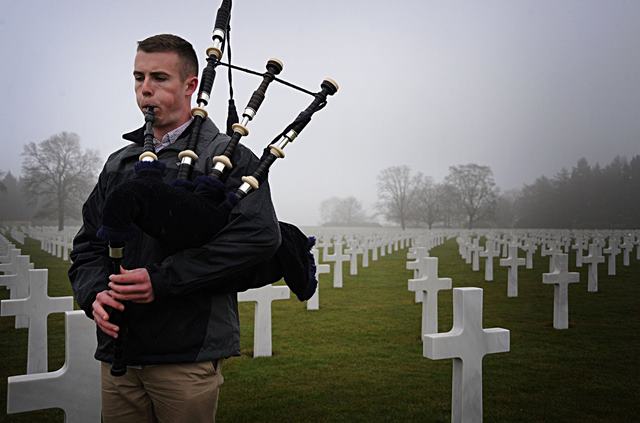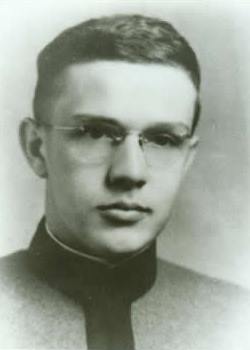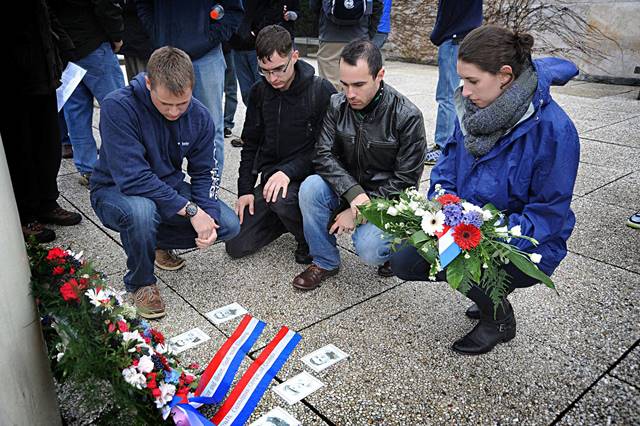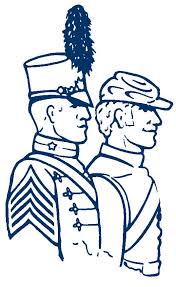More than a name in marble
Originally written and published in Dutch in the Limburg’s local newspaper on March 26, 2015.
Link naar artikel in het nederlands. Translation by W. Kiggen and M. Heemels.
AT THE NEIGHBORS [1] The Henri-Chapelle American Cemetery was yesterday dominated by the Citadel Men. Guys who were plucked from the school to fight in World War II.
by Stefan Gillissen
US military training is best known for the big screen. Movies paint a gruesome picture of the first weeks in the service of Uncle Sam, with Full Metal Jacket and Jarhead as stand outs. Breaking the will, the decompensation of the mind, creates the perfect fighting machine. It is not necessarily an incorrect observation, but one without qualification. Training is needed to forge a unit that follows commands in wartime.
 A Citadel cadet plays for the fallen men. Photo Arnaud Nilwik
A Citadel cadet plays for the fallen men. Photo Arnaud Nilwik
But not only in the army do candidates undergo Bootcamp or what is called Hell Week. Also at American military academies, cadets are subject to a heavy introduction. From there, at least 40 percent of the men and women will go into active military service in 2015, and they are a showcase for the country. Formed by brutal workout, driven by honor and love.
One of the academies is The Citadel. Seventy years ago: many students of that school in South Carolina left their homes and country. Before their graduation, they went into the military service to repel the Nazis in Europe. The price to be paid by many was painfully high; and then relatives should welcome the return of remains.
Relatives of tens of Citadel Men were not even awarded that. Their loved ones found their final resting place at several cemeteries in Europe. For example, in Margraten and the Belgian Henri-Chapelle (in Hombourg). On the last cemetery, five young men from The Citadel are fairly anonymously between 7987 brothers. However, as it emerged yesterday, they are not forgotten.
At Henri-Chapelle a group of young people from the Citadel follow in the footsteps of their predecessors. This is on the initiative of their history professor, Kyle Sinisi. The Limburg-based Citadel Memorial Foundation Europe Foundation is also present. They provided assistance with the visits to WWII cemeteries in France, Luxembourg and Belgium. The objective of the foundation is to remember and honor the Citadel Men who died in Europe or North Africa. Through research a face is given to the names engraved in marble.
One of them is a Private Walter Steele Covington. The 19-year-old student fought with the 28th Infantry Regiment in Europe. It is a hardened group of soldiers that are active in the D-Day landings, during the battle for the French city of Brest, in the bloody battle in Hürtgenwald, and during the Battle of the Bulge.
 Walter Steele Covington, Jr., Class of 1946
Walter Steele Covington, Jr., Class of 1946
Covington writes a letter to his parents mid November 1944 from Luxembourg, but then it is quiet. Nobody in the army knows, after a shootout on December 9, 1944, where he is, giving reason to list him as Missing in Action. The last place where Walter is seen is the German town of Vossenack, about fifty kilometers from the Dutch border. It happens often that soldiers end up in other armies or companies or they are taken away as a POW. The chaos during the (unexpectedly rapid) battle is sometimes complete. That gives his family hope.
See also: Sad Message Reaches Parents
However, good news does not follow. A telegram from Western Union issued on 12 March: To my regret, I must inform you that your son, Private Walter S. Covington, Jr., died on December 9, 1944 in Germany. The son of Walter and Agnes, brother of Dorothy, has fallen prey to what later will be called the Death Factory. the Hürtgen Forest.
In what has been called by veterans a heavier battle than D-Day, an estimated 30,000 American soldiers were killed. Walter died a week before the leaders decided to pass left of the woods. A choice that in the opinions of historians and veterans should have been made much earlier.
 Citadel cadets during the ceremony at Henri-Chapelle. Photo Arnaud Nilwik
Citadel cadets during the ceremony at Henri-Chapelle. Photo Arnaud Nilwik
The cadets of The Citadel of 2015 show gratitude for the sacrifice of Walter. But also the other Citadel Men, 7,000 miles from their home state, receive a special tribute. Private Waverly Owen Skidmore, Lieutenant William Herbert Ellis, First Lieutenant Albert Starke Hagood and Captain James Lawrence Manning by each the group stands silent.
The cadets listen carefully to the stories told by Bobby Bell, manager of the cemetery. Although it is not new information. “These boys and girls know exactly what happened in Europe,” says Professor Sinisi. Under the statute of the archangel who for decades has watched over the American cemetery, the group comes to silent attention to lay a wreath. From the tower the Star-Spangled Banner sounds, a bagpiper lets Amazing Grace drone across the marble crosses and with the traditional Taps the brief ceremony is concluded. It is certainly not the last tribute. The Citadel will ensure that her students will never be forgotten.
See also: The 70th Anniversary of The Class that Never Was
The Class of ’44, the Citadel class that never was
At seventeen cemeteries in Europe and North Africa, 47 men from The Citadel rest. Another Nine were never found. The Dutch-based Citadel Memorial Europe Foundation is an organization dedicated to researching, recording and sharing stories about the fallen soldiers. Thus preserving the memories of the men.
The foundation was established in 2013 by a resident of Heythuysen, chairman Roger Long. He graduated in 1989 from The Citadel. Moreover, the foundation consists of Dutch and Americans. “We are very grateful for the fact that the eight graves in Margraten and five in Henri-Chapelle are adopted. We also maintain very good contacts with the adopters, “says vice-chairman Maurice Heemels.
At the American Cemetery in Margraten are two men of the Class of ’44, the so-called “class that never was.” They are the Lieutenants Creswell Garlington, and Arthur Bradlee Hunt. The students would have graduated in 1944, but they were called to service in their final year and could not receive a degree. Of the students, 34 did not return.
© Copyright 2015 Dagblad De Limburger / Limburgs Dagblad. Copyright, also with regard to Article 15 AW, is expressly reserved. Thursday, March 26, 2015
[1] “At the neighbors” is weekly column highlighting happenings across the border in Belgium or Germany.

Comments (2)